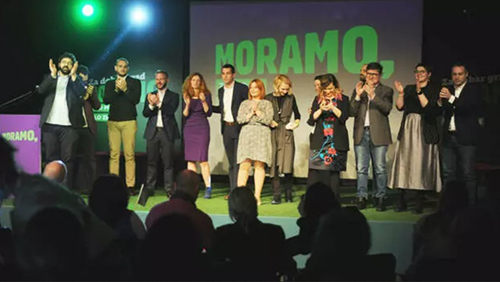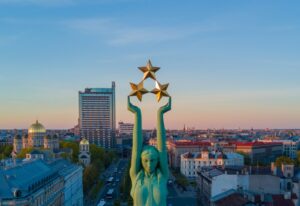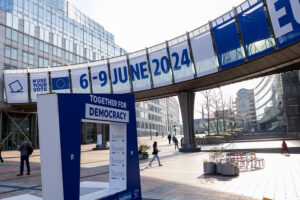Recent elections returned Aleksandar Vučić to power, but a new progressive coalition is steadily gaining ground.
Serbia held a triple election on 3 April, encompassing regular presidential elections, regular local elections in a number of municipalities, and snap parliamentary elections.
Due to the opposition’s boycott of the parliamentary elections in 2020, the National Assembly had been dominated by the ruling party, President Aleksandar Vučić’s Serbian Progressive Party (SNS) — one of the reasons why early parliamentary elections were called. Yet it was also in the ruling party’s interests to have elections at all levels of government overlap with the presidential elections, in order to personalize them as much as possible.
While the presidential elections were uneventful, the snap parliamentary elections were the scene of heightened tension. At the municipal level, the Belgrade elections drew the most interest. For the first time in many years, there was hope for a change in government at least at the local level.
Although the ruling coalition is still being sorted out, one thing is obvious: the rule of Aleksandar Vučić and SNS was shaken. They have not fallen, but despite their efforts to make the voting process more difficult, the election results are not as convincing as in previous election cycles. The same is true for their biggest coalition partner, the Socialist Party of Serbia (SPS).
Although Vučić won the first round of the presidential elections, the SNS does not hold a majority in the National Assembly. At the time of this writing, the SNS and SPS had still not managed to form a majority in the Belgrade city assembly, either. It is unclear how this situation will be resolved.
In several other cities and municipalities that held elections last week, the SNS and SPS suffered notable losses. The most interesting outcome was the success of the green-left coalition Moramo (Serbian for “We must!”) as a potential new force in Serbian political life. Moramo entered parliament with 4.7 percent of the vote and won 11 percent in Belgrade, making it the third-strongest political force in the capital (due to a large number of irregularities, there are still no final official results).
Unequal and Combined
Serbia’s democracy has been in constant decline since the SNS came to power in 2012. Opposition parties do not have equal access to the media, nor can their influence be compared to that of Vučić, whose ties and meddling in the industry are well-known. People are often pressured to vote for the SNS to keep their jobs. If small or medium-sized businesses decide to donate to the opposition, they soon face the wrath of local authorities. Trade unions are also often controlled by the government.
This year’s elections did not take place in a fair and democratic atmosphere, either. The CRTA observation mission stated that the election was “poorly organized and full of tensions that on several occasions escalated into physical violence”, a consequence of the “continuous degradation of the integrity of the electoral process in its entirety, which was marked by strengthening and sophistication of mechanisms of electoral corruption, and endangerment of citizens’ voting rights”. According to CRTA data, “repetition of serious electoral breaches” occurred in 5 percent of polling stations.
The president of the Movement of Free Citizens was attacked and beaten on election day, as was an activist from the grassroots movement Ne davimo Beograd. Cases of vote-buying, group voting, parallel voter lists, and so-called “carousel voting” were also registered.
Many polling stations, especially in Belgrade, experienced crowding and voters waiting in long lines. This resulted in some people turning away without voting, while others exercised their right after 20:00, when polling stations officially closed — something that has never happened in Serbia before. The crowds were a consequence of the local administration’s decision to reduce the number of polling stations in most city municipalities, but were also caused by the SNS directive to its polling station representatives to leave their positions across Belgrade simultaneously, thus slowing down the process even more.
The reason for such machinations is the very small margins by which the election was decided. Vučić’s party deployed various tactics to discourage voting. It also seems that the regime was working hard to provoke conflicts. Deliberately creating a crowd on election day made the atmosphere extremely tense, and the scandalous decision of the Republic Election Commission (RIK) to stop working on election night and announce the preliminary election results only the next evening added fuel to the fire. Police were soon deployed in front of the RIK, which made the atmosphere even more tense. In the days before the elections, the situation was exacerbated by the Minister of Police, Aleksandar Vulin, with statements that the opposition, helped by foreign security services, was preparing to steal the election and overthrow the government in a so-called “Serbian Maidan”.
This, of course, was complete nonsense, as the opposition neither has the resources to influence the electoral will of the citizens in any way, nor did it seek to overthrow the regime through violence and electoral manipulation. Therefore, the opposition’s decision not to protest on election night, despite the irregularities that took place, was correct and politically wise. In a situation where every single vote in the capital could potentially make a difference, it is inadvisable to do anything that would feed arguments that the opposition came to power illegally, illegitimately, and with the help of street violence.
Coalitions and Campaigns
Several political coalitions were formed in the runup to the April elections. The SNS formed the electoral list “Aleksandar Vučić — Together We Can Do Everything” with several of its satellite parties. As expected, their candidate for president was Aleksandar Vučić. Their partners, the SPS, had their own lists, but they did not have a presidential candidate, and supported Vučić. The largest opposition bloc was the centrist alliance United for the Victory of Serbia, whose presidential candidate was General Zdravko Ponoš. The green-left coalition Moramo consisted of Ne davimo Beograd, Open Civic Platform Action, Ecological Uprising, the Political Platform Solidarity, A Choice for Our Municipality. and the Roma Forum of Serbia. Their presidential candidate was Biljana Stojković.
The Right also had several lists, the most prominent being the National Democratic Alternative led by the Democratic Party of Serbia (DSS) and the Movement for the Renewal of the Kingdom of Serbia (POKS) with Miloš Jovanović as its presidential candidate. Other right-wing coalitions were the Patriotic Bloc for the Renewal of Serbia led by Boško Obradović, which consisted of Dveri and the other half of POKS, and the right-populist party Oathkeepers with Milica Đurđević-Stamenkovski as presidential candidate. Other right-wing candidates like Saša Radulović of the Sovereigntists and Vojislav Šešelj’s Serbian Radical Party did not pass the 3-percent threshold.
The war in Ukraine had a significant impact on the election. Although progressive actors managed to push environmental and socio-economic issues to the fore, as evidenced by the massive environmental protests held across Serbia in the run-up to the election, the Ukraine war made questions of identity more salient in public debate. The shock of war also impacted media coverage of the election, with more attention devoted to the right wing’s pro-Russian rallies held in Belgrade. While making liberal public uncomfortable, the rallies helped further the homogenization of the right-wing electorate.
The SNS sought to play both sides in Ukraine: Serbia voted for the resolution condemning Russia’s military aggression in the UN General Assembly, but decided not to impose sanctions. The key slogans from Vučić and his party during the campaign were “peace” and “stability” (they ditched their initial slogan, “Together We Can Do Everything”, when the war began). In that way, they sought to present themselves as the only viable option to guarantee Serbia’s military neutrality. Vučić’s junior coalition partner, the SPS, is traditionally closer to Russia, and thus openly opposed to sanctions.
The liberal-democratic opposition condemned the Russian aggression but clearly stated that it did not mean that Serbia should join NATO. Throughout the campaign, Moramo tried to raise the issues of environmental protection, labour rights, and workplace democracy, but in the end it appears they were overshadowed by the war, inflation, and global insecurity, to the benefit of the ruling coalition.
The SNS in Decline?
Vučić convincingly won his next term in the first round, securing 58.5 percent of the popular vote and far outpacing Zdravko Ponoš, who won 18.3 percent. The third-place candidate Miloš Jovanović ended up with only 6 percent. That said, the presidential elections were the least uncertain, and Vučić was expected to win.
A change of government on the national level was not expected either, but the results suggest that the SNS is in decline, especially compared to the 2016 parliamentary elections — the last time the opposition participated. Six years ago, the SNS won 1,823,000 votes and an absolute majority with 131 out of 250 seats. In the 2022 elections, preliminary results suggest that Vučić and his coalition won 120 seats with just over 1,570,000 votes. All in, they lost about 250,000 votes, meaning they can no longer form a majority on their own, even with the help of their loyal partner, the Party of Vojvodina Hungarians, closely tied to Viktor Orbán’s Fidesz party in Hungary.
The SPS achieved almost identical results as six years ago, and thus could now demand more in a possible coalition with the SNS. Yet dissonant tones have already begun to emerge between the coalition partners. Senior officials in both parties engaged in mutual attacks in the media, throwing doubt on future negotiations. Things are further complicated by the SPS’s sharp opposition to the Russian sanctions. If forced to make a decisive turn to align with EU foreign policy, Vučić will have to seek wider support for his coalition. It is clear that the formation of a new government will be delayed, and the more time passes, the more obvious it becomes that foreign policy will play a big role. Serbia’s vote to expel Russia from the UN Human Rights Council just a few days after the election is further confirmation of this scenario.
Although a glimpse at the list of candidates suggests that the right wing is far stronger in the 2022 National Assembly, the situation is not as discouraging as it seems. For the past 20 years, the Serbian Right could count on 10–15 percent of the popular vote. Right-wing votes were distributed differently among the parties this time around, but their total presence in the Assembly remains approximately the same. More right-wing parties entered parliament because of lowered electoral threshold, which went from 5 to 3 percent. The NADA coalition won 5.39 percent, Dveri–POKS won 3.83 percent, and the Oathkeepers counted 3.74 percent. The Sovereigntists missed the threshold with 2.27 percent. This is a slight difference in absolute numbers compared to 2016.
It should be emphasized that the chances of any of these anti-NATO and anti-EU right-wing parties joining the ruling coalition are very low. It is more probable that Vučić will use their presence as a scarecrow in order to strengthen his negotiating position during future talks with the EU and its allies.
Among the opposition, more was expected from the largest bloc, United for the Victory of Serbia. Its result of 13.57 percent can hardly satisfy the ambition of a coalition composed of three parties and several movements. Now, the question is how long this alliance will survive.
Even during the campaign, certain antagonisms emerged between the Party of Freedom and Justice led by Dragan Đilas and the People’s Party led by Vuk Jeremić, due to the way the Party of Freedom and Justice imposed its candidate, Zdravko Ponoš. Ponoš officially left the People’s Party shortly after the elections, and it remains to be seen whether he will support Đilas or continue his political career on his own.
In terms of political victories, Moramo was probably the biggest beneficiary of these elections. This marks the first time since the introduction of a multi-party system in Serbia that a clearly left-green party has become a factor in parliament. The grassroots coalition consists of several environmental, feminist, labour, and civic groups. During the campaign, Moramo was very present on the ground, going door-to-door and talking with people face-to-face to make up for the absence of media coverage, learning from its Croatian counterpart, Možemo.
Moramo also spent the least amount of money on TV advertising during the campaign. Instead, it organized directly and sought to target local communities’ needs and concerns. Another —somewhat surprising — first is the fact that these were the first elections that saw a political force (Moramo) prioritize pro-worker legislative reform as well as environmental protection and the rights of all minority communities. On the national level, the coalition won 4.7 percent.
Will Change Begin at the Grassroots?
The elections in Belgrade drew the most attention. For ten years, there was little doubt about the outcomes of elections at all levels of government. But this time, change was in the air. More than a week after the election, the results in Belgrade suggest a hung parliament between the ruling coalition and the opposition. Irregularities led to the elections being repeated in a few localities, meaning no final result is yet known.
Turnout in Belgrade was high with over 57.98 percent of eligible voters casting a ballot. Most likely, out of 110 councillors in the City Assembly, the SNS and SPS will be able to count on a maximum of 56 mandates. United for the Victory of Serbia could possibly count on 25 or 26. Moramo won about 90,000 votes and 13 seats. The rest of the mandates will go to right-wing parties.
In the 2018 Belgrade elections, the SNS list won 64 seats, while the list of Aleksandar Šapić, who has since joined the SNS, won 12. This time, together they can only count on 48 seats. The centrist opposition achieved almost the same result compared to the previous elections, similar to the SPS. Ne davimo Beograd, the central pillar of Moramo in Belgrade, won 3.44 percent in 2018 and did not pass the threshold. This year, three times as many people voted for them in Belgrade, demonstrating how much the Left has raised its profile over the last four years.
A more detailed look at the results shows the extent of the opposition’s success. Liberal-democratic and green-left forces combined won a convincing majority in the central districts of Stari Grad, Vračar, Savski Venac, and New Belgrade, while in Palilula, Zvezdara, Voždovac, Čukarica, and Zemun the results were either slightly in favour of the opposition or tied. In some of these districts, elections will be held as early as 2024, meaning the SNS cannot be satisfied with the current balance of power in the capital. They won mainly in the peripheral municipalities, as was expected.
The opposition also achieved excellent results in some local elections. In Bor, a city that has battled extreme air pollution for years, the SNS won only 35 percent of the vote. Kladovo and Kula also saw great performances by the opposition. These results are encouraging for opposition forces in Serbia, as it seems that the SNS regime is most vulnerable at the local level. There will be no rest for the opposition after these elections, as the next tournament will be held in two years in several Belgrade municipalities, presenting a renewed opportunity to strengthen the green-left in the city’s governing structures.
Originally published on the website of the Rosa-Luxemburg-Stiftung.
Image: Candidates and supporters of the green-left coalition Moramo celebrate their results on election night. Source: Facebook / Ne davimo Beograd



